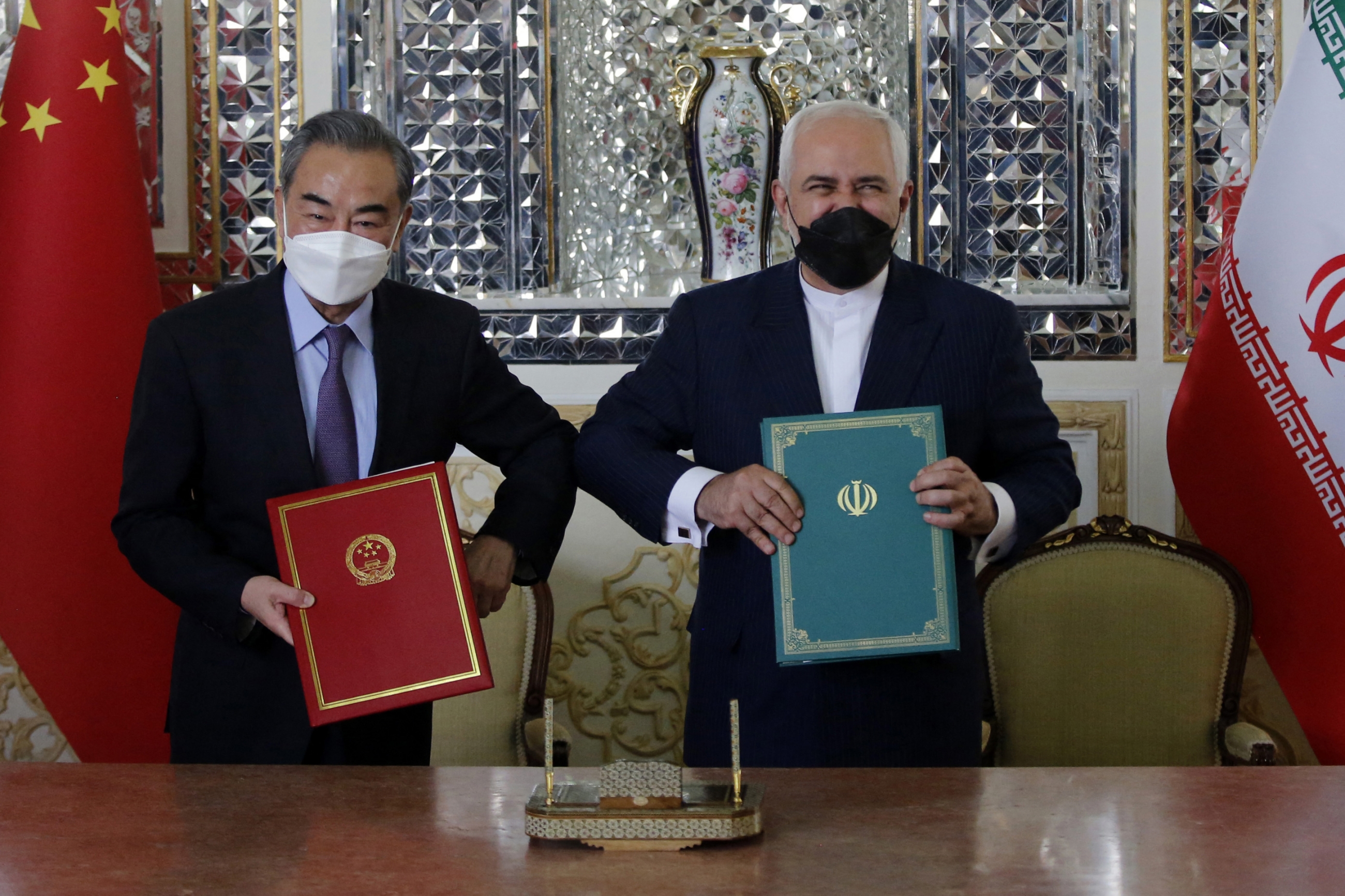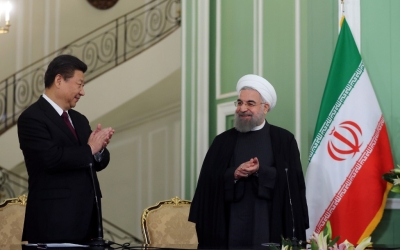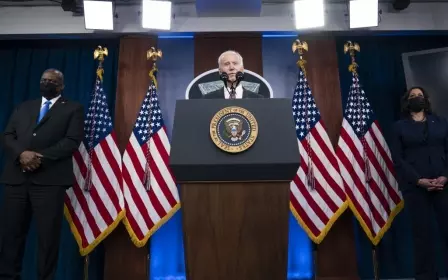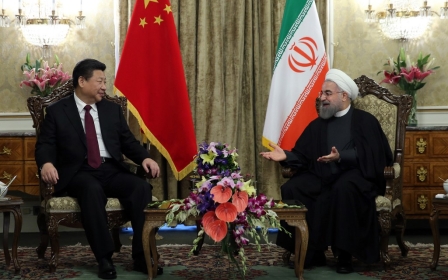Iran-China deal: A strategic card to push back against US dominance

After months of behind-the-scenes talks, Iran and China last month signed a strategic cooperation agreement aimed at cementing their economic and political alliance.
Unusually, Iranian Supreme Leader Ayatollah Ali Khamenei personally handled the process, bypassing the Rouhani administration to appoint former parliament speaker Ali Larijani as the liaison with China. The reformist daily Shargh noted last year that Larijani’s position as an adviser to the supreme leader would convince the Chinese that Iran was serious about the deal.
China aims to assure the Iranian government that it has Beijing's support as a strategic ally
Has Khamenei adopted a solid stance on the revival of the Iran nuclear deal, relying on Chinese support in general and this agreement in particular? He has appeared inflexible and repeatedly reiterated Iran’s “definite policy” that Washington must first lift all sanctions before Tehran resumes its commitments under the 2015 deal.
While we might not be able to answer the above question with certainty, the signing of the Iran-China accord raises other important questions. Has China opted to openly challenge the US at the international level by “strategically” supporting the government most hostile to the US? Will this agreement actually become operative?
Neither the Iranian nor the Chinese government has made the details of the agreement public, but it is believed to be largely unchanged from an 18-page draft the New York Times obtained last year. That draft detailed $400bn of Chinese investments in Iran, in sectors such as energy and infrastructure, over the next 25 years. In exchange, “China would receive a regular - and, according to an Iranian official and an oil trader, heavily discounted - supply of Iranian oil,” the Times reported.
New MEE newsletter: Jerusalem Dispatch
Sign up to get the latest insights and analysis on Israel-Palestine, alongside Turkey Unpacked and other MEE newsletters
To answer the previous questions, we need to understand how the agreement fits into China-US relations at the macro level.
The conflict between the US and China significantly escalated during the presidency of Donald Trump, who took his anti-China rhetoric to a global stage, labelling the coronavirus pandemic the “Chinese virus”.
Last June, in an unusual move, the US Navy sent three of its 11 nuclear aircraft carriers to the Pacific, where several regional countries have challenged China’s claim to about 90 percent of the South China Sea. The waters are home to hydrocarbon reserves, but above all, fishing is at the heart of the dispute. The disputed waters accounted for 12 percent of the global fish catch in 2015, with more than half of the world’s fishing vessels estimated to operate there.
Growing rivalry
Beyond the trade war that escalated after the start of the Covid-19 pandemic, Hong Kong has been another flashpoint. After pro-democracy protesters took to the streets in 2019 and 2020, Trump issued an executive order that eliminated preferential treatment for Hong Kong under a range of US laws. Hong Kong serves as a conduit for much-needed US dollars into China’s economic system.
The dispute over Taiwan’s fate has also had the potential to erupt into conflict between China and the US for decades.
China-US rivalry reached such a point that former national security adviser Robert O’Brien warned last year that Beijing sought to take advantage of the coronavirus crisis “to displace the United States as the leading global power”. Former Secretary of State Mike Pompeo, using rhetoric not heard by an American politician in decades, noted: “If the free world doesn’t change Communist China, Communist China will change us.”
This worldview has not changed significantly under President Joe Biden. He recently singled out a “growing rivalry with China” as a key challenge facing the US - a viewpoint reflected in a 24-page document outlining Biden’s national security policies. It states: “China, in particular, has rapidly become more assertive. It is the only competitor potentially capable of combining its economic, diplomatic, military and technological power to mount a sustained challenge to a stable and open international system.”
Significant challenge
It is against this backdrop that the 25-year Iran-China agreement has emerged. Considering the current state of US-China relations, what would it mean if the agreement becomes operative?
Firstly, it would mean that the Chinese have decided to ignore US sanctions on Iran, if those sanctions are still in place. This would be a new approach. Following the reimposition of sanctions by Trump, Chinese carmakers left Iran, along with other foreign manufacturers, and the China National Petroleum Corporation withdrew from phase 11 of the giant South Pars gas field.
Secondly, and more importantly, a 25-year agreement with Iran would mean that China has decided to openly and strategically support a government that is the most hostile to the US in the world. This would be the most significant challenge by the Chinese to the US since the end of the Vietnam War and statesman Deng Xiaoping’s historic visit to the US in 1979. But is China prepared to enter into a long, and likely ever-escalating, conflict with the US? This does not pass the logic test.
China is the largest US trade partner. Of the $7tn in US debt owned by foreign governments as of November 2020, China owned more than $1tn, second only to Japan. While “steep competition” will be a major component of US-China relations going forward, such an astounding interdependence will not likely allow Iran to become a flashpoint that leads to a confrontation between the two superpowers.
Will the deal become reality?
China’s National Defense in the New Era is a detailed response to the shift in US strategy, from a focus on terrorism and extremism to competition with China. The document, issued in July 2019, highlights Beijing’s focus on development: “Though a country may become strong, bellicosity will lead to its ruin … [The Chinese people] have learned the value of peace and the pressing need for development.”
China might also be playing the Iran card to push back against the US on the Taiwan, South China Sea and Hong Kong fronts
China will most likely not circumvent or disregard US sanctions at the cost of opening a new contentious front with the US. So what could be its goal in signing the agreement with Iran?
China aims to assure the Iranian government that it has Beijing’s support as a strategic ally - a vital assurance amid China’s increasing demands for oil. The timing of the deal, signed just before the start of Iran nuclear talks in Vienna last week, might not be coincidental; it could boost Khamenei’s confidence in dealing with the Americans.
China might also be playing the Iran card to push back against the US on the Taiwan, South China Sea and Hong Kong fronts.
All in all, the 25-year deal’s materialisation into reality, at least while far-reaching US sanctions remain in place, appears unlikely.
The views expressed in this article belong to the author and do not necessarily reflect the editorial policy of Middle East Eye.
Middle East Eye delivers independent and unrivalled coverage and analysis of the Middle East, North Africa and beyond. To learn more about republishing this content and the associated fees, please fill out this form. More about MEE can be found here.







